Last week two of the hives in our apiary swarmed. The Lavender colony swarmed on Sunday afternoon, followed 24 hours later by the Salvia colony. Both hives had been split this spring prior to the swarms, Lavender was split as recently as two weeks ago, but after inspecting the hives this weekend, it’s clear we should have split much more aggressively.
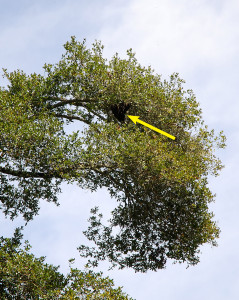
The Salvia colony produced a large swarm the day after Lavender swarmed (click any image to enlarge)
As both hives cast substantially large initial swarms we wanted to see what the situation was inside the hives post-swarm. Robust colonies will frequently throw multiple swarms during a season if they remain crowded.
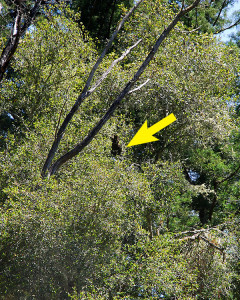
Three days after swarming, we watched as the Salvia colony moved 100 ft south to a different oak tree
To decrease the chances of losing more bees to swarms, we needed to see if we could determine why they swarmed in the first place.
Salvia Colony
On Saturday we inspected the Salvia colony hive. The Queen in this hive has always been a bee-making machine. When we split this colony in February there was no shortage of bees, or brood.
What struck us looking into the hive after the swarm was there was no brood to speak of. None. As the colony had swarmed on Monday, we knew there would be no eggs visible, but we didn’t expect to not see any larvae, or capped worker brood. The only visible capped brood was drone brood, and not very much of that. We expected that although the Queen would cut down drastically on egg-laying prior to swarming, we didn’t think she’d stop entirely.
There was plenty of pollen, and lots of uncapped fresh nectar, although very little capped honey, which was no doubt consumed by the bees just prior to swarming.
The only thing in abundance in the hive, other than bees, was this.

In spring it's important to check the bottom of the brood frames for empty Queen cups (yellow arrows), and capped Queen cells (Red arrows) that contain new Queen larvae
Numerous empty Queen cups, and at least a half dozen capped Queen cells.
Although we systematically went through the hive frame by frame, we did not locate a new Queen. We did, however, see not one, but two Queens emerging from capped Queen cells.
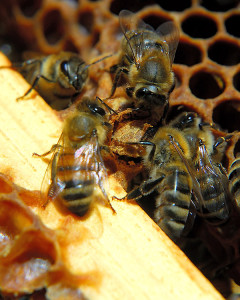
Here the worker bees appeared to be removing the cap on this Queen cell, and we could see the Queen moving inside
With so many capped Queen cells we were concerned that this colony would soon cast an afterswarm.
We felt we should split out some of the capped Queen cells into our nucleus (nuc) hives to attempt to start new colonies from them. However, the difficulty was the overt lack of capped brood to transfer in the split.
As worker bees are relatively short-lived, capped brood helps to provide insurance that there will be sufficient population within the colony to care for both the Queen, and any new eggs that a new Queen will produce. A new Queen, however, will not begin laying eggs immediately. She first needs to hatch, take her mating flight, return, and hopefully a few days thereafter begin laying eggs. Then it takes time for those eggs to hatch. If capped brood isn’t transferred, it’s a race to produce a new generation of bees before the existing population is lost through age, and attrition.
However, as there was still a substantial population of worker bees inside the Salvia hive, we went ahead and split some of the Queen cells into two new nucs . Some workers will fly out and likely return to the Salvia hive, others will be lost to age or predators in the field, and with no bees to replace them, we were careful to transfer generous numbers of worker bees into each new hive as well.
Although there was little to no capped honey, there was plenty of nectar and pollen, so each new nuc received frames of both. We were also careful to leave two intact Queen cells inside the parent Salvia hive.
It is possible for new virgin Queens to get caught up in swarms as the swarm exits the hive. As we did not definitively sight a Queen during this inspection, we didn’t want to leave this colony completely Queenless, so we had to leave some Queen cells in the hive. As there are no eggs in the hive, it is impossible for the bees to produce a new emergency Queen if we remove all the Queen cells.
Overall, our impression is that Salvia simply ran out of room. Between a large build up of brood, and a strong nectar flow, the hive simply became too crowded, as we obviously should have split this colony again. This weekend we created two new nucs from Salvia, and managed to use up all the equipment we had on hand. So before we could inspect the Lavender colony, we first had to source some extra equipment.
Lavender Colony
On Sunday, after acquiring a new bottom board, and hive cover, we set out to check on Lavender.
For the record, Sunday was the warmest day of the year so far, and wearing a bee suit, while standing in full sun in the apiary, we both almost melted into puddles. The things we do for bees!
Strangely, if you knew nothing about the history of these two hives, at first look one would presume that Lavender was the stronger of the two swarm hives. There was still capped honey in this hive, albeit not much, but there was also capped brood, quite a lot of it. There were also NINE capped Queen cells, and a few empty Queen cups.
Our strategy with Lavender was a little different. As this colony had some capped brood, and Salvia did not, rather than dividing the colony to create new hives, we opted instead to use this colony to balance resources within the apiary. We did create one split, transferring Queen cells, pollen, nectar, brood and bees. We also left enough of those same resources within Lavender to continue to sustain the colony.
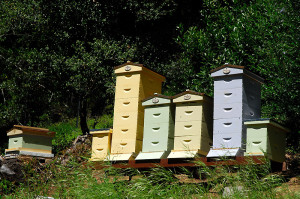
We started this spring with just two surviving colonies. Just through splits, we're now up to 7 potential colonies in the apiary
We then divided the remaining capped brood between the two nucs we’d created from Salvia the day before, in the hopes that this brood will help provide a little extra insurance in the form of new population, while their respective new Queens get established.
For us, this is one of the major reasons for having more than one hive in an apiary. It provides us with more management options. If we didn’t have a hive with extra brood available, the Salvia nucs would be less likely to survive.
While transferring bees between nucs we did have to be mindful of the fact that after the swarm, when many of the worker bees have left, the swarm colonies have a disproportionate number of drones left behind.
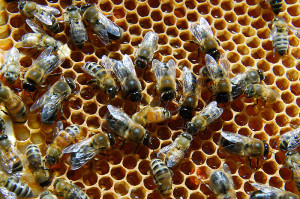
Drones are produced by the Queen prior to swarming, and after many of the workers leave, the drones are very obvious in the hive
This was especially true of Lavender, who seemed to have upwards of 40% drones at the time of this inspection. Interestingly though, the majority of the capped brood that remained was worker brood.
Drones though don’t perform any useful function within the hive, so we needed to ensure that of the bees we transferred, there were enough worker females to tend the brood until it hatches.
At the end of the weekend, with both swarm colonies inspected, we jumped from four, to SEVEN potential colonies in the apiary. However, that said, not all of these colonies may survive. We may have damaged Queen cells, there may be insufficient brood, the Queens may not return from their mating flights, or the two parent hives, Lavender and Salvia, may still swarm again, and leave those original colonies too short on population. Between swarming, and splits, there is not a single Queen in our apiary that was here last spring. Every single hive (hopefully) will have a new Queen this spring.
So now we cross our fingers, and hope for the best. We’ll keep an eye on entrance activity over the next few weeks, and then reinspect each of the colonies for evidence of new laying Queens.
In the meantime, we’re hoping at least one of our swarms found a good home.
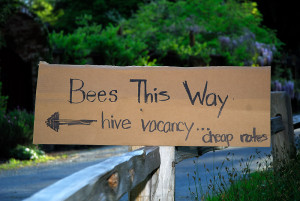
Hoping the bees can read, our neighbors, who have a hive vacancy, tried to encourage one of our swarms to move in
It really has been a remarkable ‘swarm week’, between the two swarms cast by our hives, and the three feral swarms we’ve seen pass overhead, not to mention the numerous other swarms all around the Bay Area [1,2,3], it’s been a beezy week! With rain on the way, I expect things will quiet down for a while though, which gives me the perfect opportunity to get back to planting out the new garden.
———————
[1] Locals encountering more bee swarms as spring warms up (KTVU). April 18, 2012
[2] Warm Weather Brings Swarm of Bees Early (ABC News). April 19, 2012
[3] The buzz: Honeybees are swarming, and that’s a good thing (Mercury News) April 19, 2012

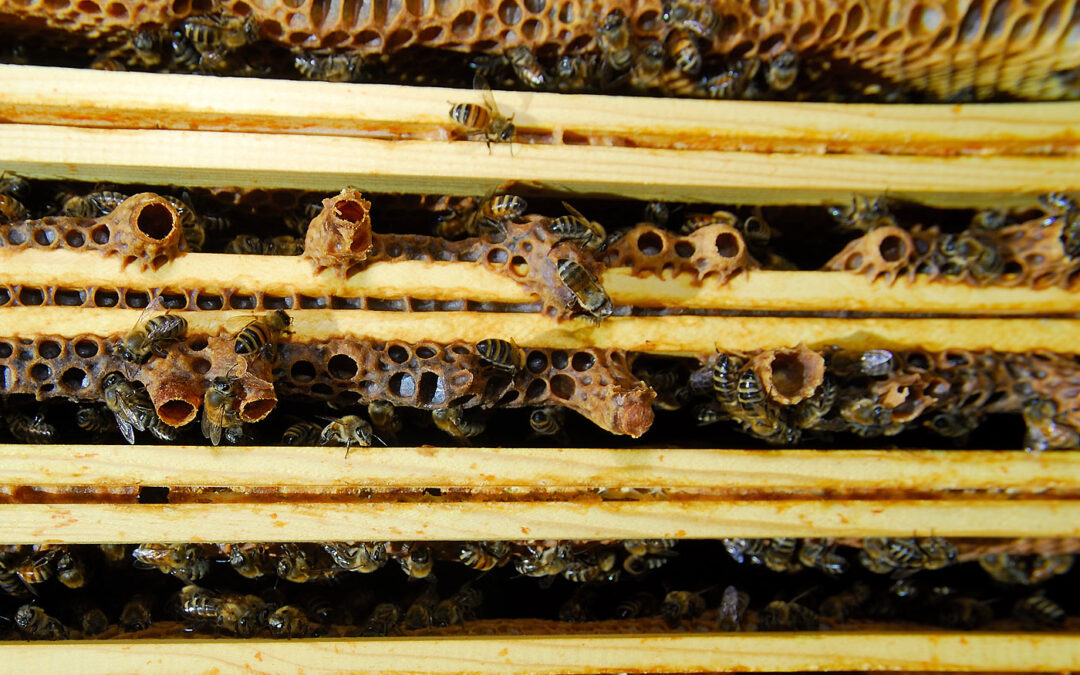
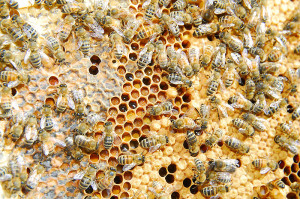
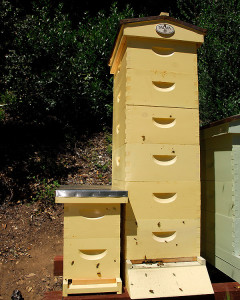
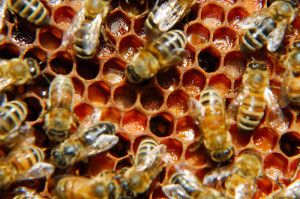
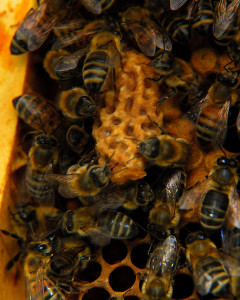
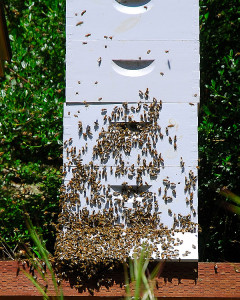








Holy cow these things take a lot of work. Although, I guess the work is to keep from losing them all. This reminds me of a soap opera…
Some beekeepers adopt the hands-off approach, but we’re a little more involved with our hives. The primary reasons to work with hives in spring to prevent swarming are first, to conserve the honey harvest (because swarms take a lot of the honey with them), and second, to prevent a swarm moving into a neighbor’s shed or garage. However, sometimes the bees will swarm regardless of what the beekeeper does. Fortunately, there are times of the year when the bees don’t need quite so much of our attention though 😉
Clare, you always amaze me with your writing; I am constantly learning from you. After reading this, I shall admit to being thankful I didn’t convince my dh into getting bees. lol… the chicks I can handle, but with everything else, I don’t know how you do it all.
You should my list of ‘things to do’ that still isn’t done. I’ve been about three weeks behind all spring, and I think the bees last week pushed me another week further behind 😉 It’s funny, I remember reading (before we got bees) that bees are more work than a cat, but less work than a dog. I agree, that’s true, most of the year. However, there are times of the year where we do have to pay particular attention to when there’s a nectar flow, and how much the hives are building up. This year, I think we dropped the ball though!
Those bees must really love your yard and all you have planted for them! That’s pretty amazing that you now have 7 after starting with 2. I really enjoy these bee posts!
I think the bees will be especially happy with our recent trip to the nursery. We came home with FIVE different cultivars of Ceanothus, and a few other plants too. Now I just have to dig a LOT of holes this week, and get all those new plants in the ground!
Clare,
Wow, things quickly change don’t they. Do you think you’ll have a honey harvest now? It is still early in the game I guess.
I’m cutting out a swarm of bees that moved into a bathroom ceiling last week today, getting paid for it too. I’ll add them to my tiny hive that needs a queen. My top bar packages bees are dragging their feet, thought they’d made more progress, but it has been cold and wet.
We may get a summer harvest, it depends how much the bees build up. At least this year they have a lot fewer combs to draw out. Last year we mostly had foundation. The good news is, it looks like the new Rosemary hive, which was our February split of the Salvia colony, is really starting to produce some bees. I’ve been watching the entrances, and activity is definitely picking up in that hive, so it’s probably time to check on them again. From the entrance at least, they definitely seem to be Queen-right.
Weather can definitely slow them down. This year we’ve had some really nice breaks between storms, so our bees haven’t been cooped up too much. Good luck with your ceiling extraction! You’re acquiring quite a lot of bees. Are you hoping to go into the honey business? 😉
Clare,
Nice calm bees today, in the ceiling for 9 days and they had drawn 11-13 small combs. Not sure if we got the queen. looked like 4-5 pounds of bees. Three stings all my fault, crushing the bees. Hive 6 is full, I added them to a small swarm that workers were laying in, they needed a queen just the same.
Hopefully you got the Queen, you should know soon. Did you shake out the laying worker hive? I haven’t had to deal with one yet, but I’ve read that a laying worker colony won’t accept a new Queen, so the recommendation is to shake out that hive, and let them drift into a nearby one.
Clare,
Didn’t shake them out. I put a newspaper between them and added about 10 times more bees to the box above them. Figured the number of bees would sort it out.
I’m surprised the swarms are still hanging out in the trees. How often does it normally take for them to find a new home? I would think it would be dangerous for them to hang out in the open too long. Glad to see so many hives at work in your yard though. It was so sad to see the other two colonies collapse, this more than makes up for it.
Salvia was up in the tree until very late Friday afternoon, she swarmed Monday! It only took Lavender a couple of days to move on. Most books suggest that colonies find new accommodation in 1-4 days. However, there are risks in the meantime. If a rainstorm kicks up, or they don’t find a new home in time, the colony could die. I was watching Salvia up in the oak after that swarm moved to the other tree, and the wind started whipping up. Watching that cone of bees swaying 6-8 feet back and forth was quite amazing. Somehow though, they all managed to hang on for the ride! I’ve never looked it up, but with as many bee colonies as swarmed all over the area last week, I do wonder if bees are sensitive to barometric pressure. It seems they must know when the barometer is rising, and weather conditions are improving. They certainly were smart enough not to come out in the stormy weather the week before! 😉
My, it really takes a lot of work to tend bees. A lot of knowledge too. I never see bees swarming and would like to see this sometime. Do they have a plan when they leave, do you know, or is it a search mission? Do they send out scout bees?
It’s my understanding, from reading books like ‘Honeybee Democracy’ by Thomas Seeley, that the bees may sort of have a plan when they leave, but it’s not necessarily finalized, although in some cases there may be no plan at all until after they leave. They do send out scouts to scope out new real estate, but the scouts then have to convince the colony that the location they’ve found is the best one. I can just imagine the bees, stuck up in their tree, waiting to move into a new house, while the scouts are arguing among themselves as to which property has the most square footage, or the lowest rent 😉 As they don’t forage much while clustered, depending mostly on the food reserves they carried with them, it’s important they reach that consensus fairly quickly. There are occasions where swarms will get caught out for extended periods, and in those cases the bees can become quite irritated. So although swarms are generally calm, it’s still a good idea to leave them be, unless of course you’re a beekeeper, and can actually reach them!
Seeing all of those queen cells and cups gives me goosebumps! The stuff of nightmares really but am glad you managed to get a couple of nuclei off of your hive.
You have SO many supers on your hive…what an amazing amount of honey! Is the bottom box the only one you use for brood? There’s a system here called brood and half where the queen excluder is placed not on top of the brood but on top of the first super. This way the colony can spread out a bit and maybe it could help your situation if you’re not already using a similar technique?
I wish it was honey! These bees were from feral swarms last year. They don’t make much honey, but they’re really good at making lots of bees! Last year, the tall yellow hive had FOUR boxes of BROOD! It’s always been a challenge to stay ahead of population. The hives do look a little tall, but that’s primarily because we’re using 8-frame medium hive bodies, which are smaller than standard Langstroth hives. With the apiary on a slope, it makes the hive bodies less heavy, but the downside is you end up with a skyscraper for a hive! 😛 Up until now, as the bees weren’t making much honey, we haven’t actually used the Queen excluders. I bought some last year, but they’re covered in dust in the office. We’d probably still have to leave at least 3 boxes for brood if we used an excluder. If the bees build up quickly again, we’ll definitely find ourselves doing some late season splits, and hive balancing! The good news is, with the swarms, it’s broken the Varroa mite cycle for the spring.
Even with only eight frames per box that is a whole lotta bees! 32 frames of brood…crazy. On the plus side, they’re bound to start being productive with those kind of numbers 🙂
I’m aware of Varroa but fortunately we don’t have it here on the Isle of Man. [Knocking on wood vigorously!] The infestations sound horrible though so that’s wonderful that you’ve been able to dodge their cycle for awhile.
Those bees seem like such a lot of work and time. But how wonderful to have possibly seven colonies from just two! That’s better than any plant division! Cute sign your neighbor put out! 🙂
Bees are a little work, at certain times of the eyar, but we love having them here. You’re right, when I divide plants, I’m never that lucky! 😉
It never ceases to amaze me how complex bee hives. We humans think we have it all figured out but we actually aren’t as smart as bees.
Bees are significantly more intelligent than us, I’m certain of it. This year (except in regards to swarming), we’re planning to be a little more hands off. Honestly, bees evolved just fine without beekeepers in the past. We just want to ensure they have what they need, but other than that, I know the the bees know best 🙂
fascinating post. I didn’t know beekeeping was so complicated. I don’t know how you do it all. Good luck getting your gardening, what with bees, goats, chickens and turkeys.
That’s exactly the problem at the moment. I’ve spent the whole week in the greenhouse desperately trying to catch up in the garden this week! I’m sooooooo far behind 😉
Wow! You have been busy (as have your bees). Are the neighbors who are trying to attract your swarm the same neighbors whose swarm you captured last year? If so, it gives new meaning to “what goes around comes around” 🙂
No, these are our neighbors at the bottom of the hill. They did capture a third swarm from the same neighbors we sourced our bees from though. We’re so lucky to live in such a bee friendly neighborhood! 😉
Oh such drama Clare – there’s never a dull moment at Curbstone! Bee keeping certainly is a sharp learning curve and it seems like every year you’ve got something new to face. A few years ago my friend has a swarm that decided to stop for a breather in her garden. She was quite scared at first but then that turned to amazement as she watched them take off again.
Fingers crossed that you’ve got some Queens in there!
It’s very easy to become engrossed when you’re staring at bees. They never cease to amaze and fascinate me, and they always have something new to teach us. Every time we enter the hives we see something different. Ultimately I think it’s important to trust that the bees know what they’re doing. As beekeepers we’re just there to lend a helping hand if needed.
I noticed your first commenter mentioned a soap opera, and that is what I was thinking, too! I never knew so much about bees or how interesting it all is, not to mention the work involved! I do hope your swarms find good homes. Would they set up in an old hollow tree?
It really is like a series of “As the Hive Churns”! It really does give you a whole new appreciation for honey, doesn’t it? The bees will set up resident in hollow cavities, in trees (or attics). We’ve been able to hear a colony above the house somewhere up on one of the slopes since last year. For the life of me I just can’t see them, but we hear them frequently. There are many hollow trees here on the property, especially as most of our Pacific Madrones are dying, and many of our oaks are less than healthy. I’m sure there’s room for a number of additional swarms here 😉
I came from your tomato grafting post before coming here, and i am so amazed of the bulk of work you are doing, and you are doing everything fully well. After that you still can write your post here perfectly and beautifully that all of us are excited and enticed to finish. Then you still can reply to all comments so profoundly and helpfully. You are an idol, if only i am there i will apply for an internship! I also read all the comments and replies because i learned lots from them.
We have native bees and stingless bees in our property, which is not very common now in these parts. They are on hollows of trees, we just let them there and i just came by sometimes to know if they are still there!